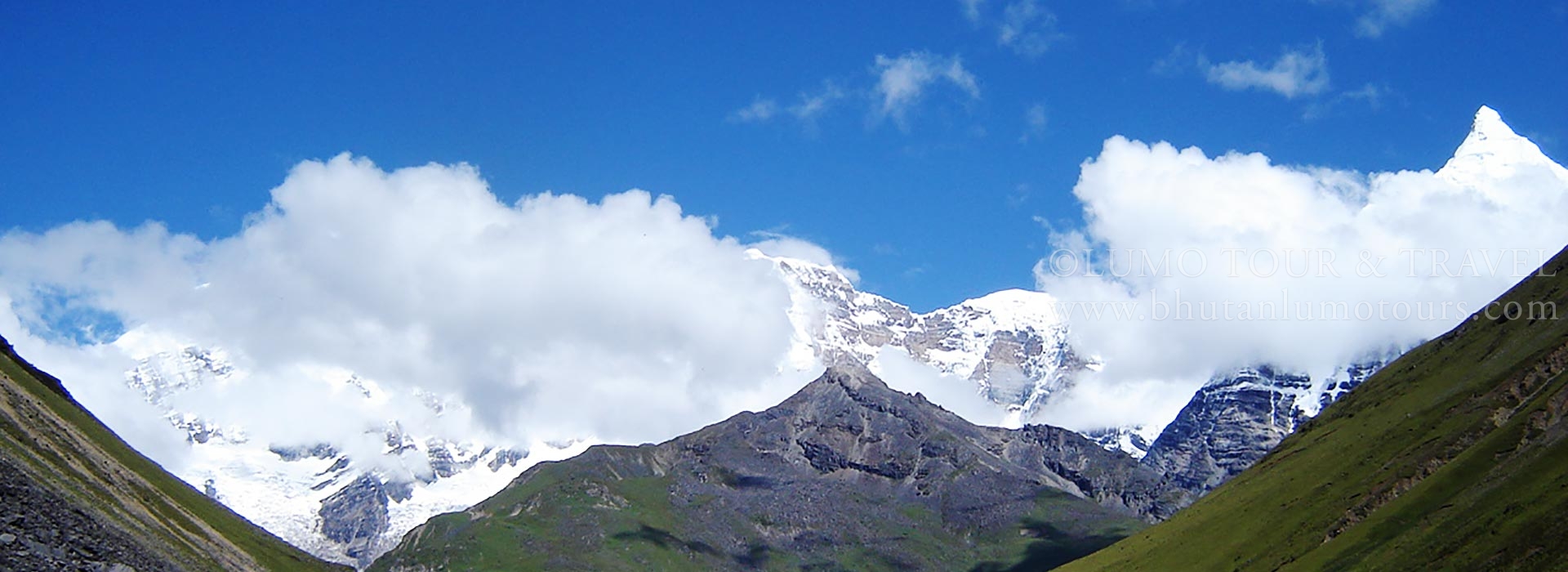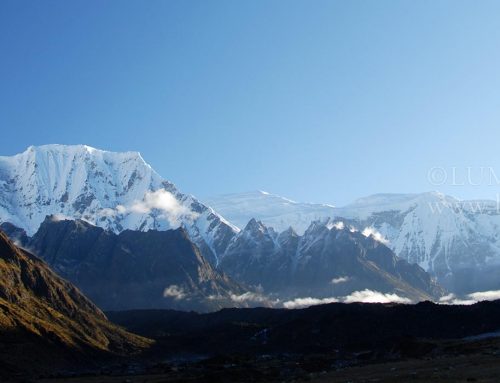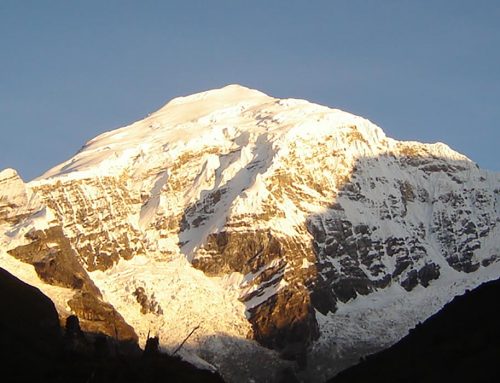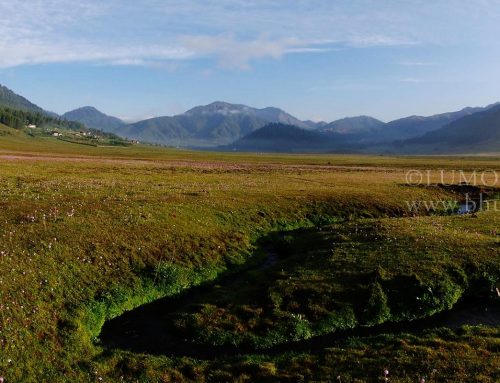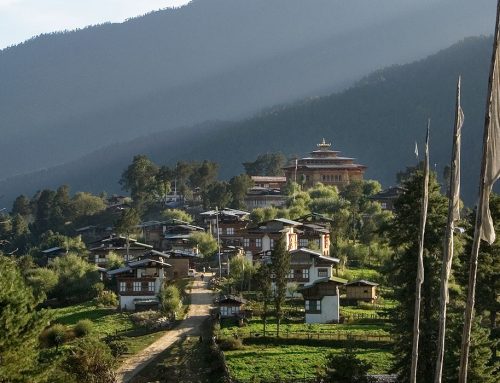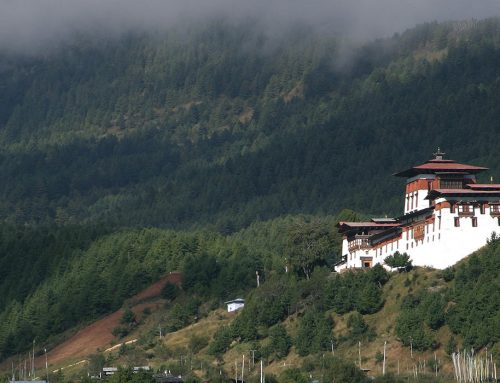- Duration: 14 nights / 15 days.
- Accommodation: Tents.
- Activity Type: Walking, Trekking.
- Difficulty Level: Strenuous.
- Highest point: 4900 meters.
- Group size: Minimum 2 pax
- Best Months for the Trek: March – May, September – 2nd Week of December.
- Spectacular view of Mt. Jhomolhari (7314m).
- Excursion to the famous Tiger’s Nest – Taktsang Monastery.
- Visit to Drugyal Dzong (The Ruined Victory Fortress).
- You can see the Blue sheep and come across the Yak herders’ camp.
- Visit Kichu Monastery (built in 7th century) and the National Memorial Chorten.
- Visit the tallest Statue of Buddha in Bhutan.
- A panoramic view of the Higher Himalayas from the Dochu La Pass (3140m).
- Visit Punakha Dzong (built in 1637) and Chimi Lhakhang – “The Temple of Fertility”.
This route is very popular and passes through Jangothang and the base of Mt. Jumolhari. The trek runs through some of the most beautiful high passes and Yak herders’ camp. The trekkers will be able to see some of the most spectacular sceneries of the higher Himalayas including Mt. Jichu Drake. You will also have the opportunity to see Blue sheep and other exotic wild life in along the trekking route.
ITINERARY
DAY 01. ARRIVE AT PARO, 2280 METERS, BY DRUK AIR:
The flight into Paro is a befitting introduction to the spectacular beauty of Bhutan. In clear weather, you will be able to see some of the world’s highest peaks as you fly into Paro. As the aircraft prepares for landing, you will be surrounded by the lush green valleys. On landing, your Bhutanese escort from Druk & Drukpa Travel will greet you at the exit terminal, and then drive you the short distance to the Hotel. In the evening, you are free to stroll in the town for photography. Overnight in a hotel.
DAY 02. PARO, 2280 METERS:
After breakfast you will visit the Ta Dzong, an ancient watchtower, now the National Museum. Just below the Museum, sitting atop a knoll is the Paro Rinpung Dzong, the center of civil and religious authority of Paro district. You will cross a beautiful cantilever bridge to the base of the dzong. A short distance further is one of the innumerable archery ranges (archery is the National Sport of Bhutan). If we are lucky, we may catch a match in action.
After lunch, we will drive you to the ruins of the Drukgyal Dzong (Victory Fortress) about 16 km away from Paro town. Built in 1647 by the great Shabdrung Ngawang Namgyel, father and unifier of medieval Bhutan, the dzong was destroyed by fire and has been in ruins since then – an evocative reminder of the great victories it was built to commemorate. On a clear day you will see an unforgettable view of Mt. Jhomolhari (7,314 m), the highest unclimbed peak in the world. On the way back, visit Kichu Lhakhang that was built in 659 AD by the Tibetan King Srongsen Gampo. In the evening, you are free to stroll in the town. Overnight in a hotel.
DAY 03. PARO, 2280 METERS: EXCURSION TO TAKTSANG MONASTERY:
After breakfast a short drive will take you to Satsam Chorten, from where you start your 2-hour hike to view the spectacular Taktsang (Tiger’s Nest) monastery. The trail climbs through beautiful pine forests. You will stop for a rest and light refreshments at the Taktsang Zakhang (cafeteria) and then walk a short distance until you see, clearly and seemingly within reach, the famed Taktsang Monastery. Built in the 1600s, this incredible monastery clings to the edge of a sheer rock cliff. It is said that Guru Padmasambhava, the tantric mystic who brought Buddhism to Bhutan, came to Taktsang riding on a tigress. Lunch will be served at the cafeteria, followed by the walk back to Satsam Chorten. In the afternoon, you will visit Tachog Lhakhang and a Bhutanese Farm House. Overnight in a hotel.
DAY 04. PARO – SHANA (START OF TREK):
Our trek to Shana starts at Drukgyal Dzong at 2580 meters following the Paro River and we pass cultivated fields and tiny picturesque villages. The forests are alive with numerous birds and bright-colored butterflies. Overnight at a camp in Shana.
Altitude 2850 m; Distance 17 km; Time 5 – 6 hours; Ascent 360 meters, descent 80 meters.
DAY 05. SHANA – THANGTHANGKA:
The trail follows the river through a heavily forested area with a few isolated farmhouses. We pass a junction en route, where another path leads north over the Tremola Pass to Tibet. Camp is in a meadow with a stone shelter.
Altitude 3610 m; Distance 22 km; Time 7 – 8 hours; Ascent 770 meters ascent, descent 10 meters.
DAY 06. THANGTHANGKA – JANGOTHANG:
In the morning after passing a small army post, the trail slowly leaves the forest line and gradually climbs up to a beautiful valley, passing Tegethang, the winter home of yak herdsmen. Lunch will be served in one of these huts. You will come across a lot of yaks before we arrive at the Mt. Jhomolhari base camp (4115 m). High mountains overlook the camp and visible nearby are the ruins of an old fortress used to guard Bhutan against Tibetan invasions. Dinner and overnight in a camp.
Altitude 4080 m; Distance 19 km; Time 5 – 6 hours; Ascent 480 meters.
DAY 07. JANGOTHANG:
Rest day at Jangothang, enjoy the superb view all around.
You have three options for day hikes in Jangothang:
- Hike to Jumolhari Glacier which is around 4 ½ hours (back and forth)
- Hike to Jichu Drake Glacier which is around 3 hours (back and forth).
- Walk up the mountain between Jumolhari and Jichu Drake, the summit is at 5200 meters with a great view of both the mountains. This is 8 hours (back and forth).
DAY 08. JANGOTHANG – DHUMZO (SOI YAKTSA) AT 3800 METERS VIA BONTELA PASS 4900 METERS
Highest Point 4900 meters; Duration 7 – 8 hours walk; Distance 16 km; Level of Difficulty – moderately hard.
We will cover a distance of 16 km and will take around 7 – 8 hours to reach the Dhumzo camp site. On the way you will see the view of Mt. Jhomolhari, mt. Jichu Drake. You will also come across the several yak herders’ tent, Tsho Phu lakes and might even see a flock of Himalayan blue Sheep high up on the rocky slopes. If you are lucky you may see footprints of Snow Leopards at the Bontela Pass. Then the trail winds up till Bontela (4900m) and is also the highest point of this trek. From here you can see several mountain peaks. The trail drops through a steep, narrow gully with gravel and loose rocks till you reach Dhumzo. The Soi Yaktsa Valley is a beautiful site with impressive rock cliffs, waterfalls, deep side valleys, and snow-covered peaks. Dinner and overnight in a camp.
DAY 09. DHUMZO (SOI YAKTSA) – THOMBUSHONG (4100 METERS) VIA TAGALUN PASS AT 4550 METERS.
Highest Point 4550 meters; Duration 5-6 hours walk; Distance 14 km; Level of difficulty – Moderate.
You will walk through rhododendron, birch, and oak forest draped in moss until you reach a meadow with huge juniper trees. From here you reach a shoulder of a ridge from where you walk straight into a beautiful valley with a number of Yak herders’ camp. You can also get a view of Mt. Jhomolhari for a short while. Little ahead of the Yak herders’ camp site, we stop for lunch and then there is a steep climb to the pass for about an hour. From the pass, you can see the campsite at Thombushong which is very pristine. If you are trekking during May and June, you can see Takins (Bhutan’s National Animal). This place falls in the migratory route of the Takins. Dinner and overnight in a camp.
DAY 10. THOMBUSHONG TO ZANKEPANG AT 2600 METER VIA THOMBULA PASS (4300 METERS).
Highest Point 4300 meters; Duration 7-8 hours walk; Distance 18 km, Level of Difficulty: Moderate.
From the campsite, you start your climb to Thombula Pass which takes about half an hour and then you walk on the ridge which is very beautiful. You can see the several mountain peaks view from the pass, the closest one being Mt. Jo Drake (5980 meters). The best time to walk on the ridge is during spring where the whole surrounding mountains are covered with beautiful rhododendron flowers of different colors. After a while the path descends very steeply to the army camp which takes around three hours. The camp is another easy one and a half hour trek from the army camp. Dinner and overnight in a camp.
DAY 11. ZANKEPANG TO DRUGYEL DZONG: DISTANCE 7 KMS.
This is the place where you see off your trekking staff and your horsemen. The walk to the road end is only 2 hours. End of trek. In the evening we drive to Thimphu. Overnight in a hotel.
DAY 12. THIMPHU SIGHTSEEING:
After breakfast, sightseeing in Thimphu. It includes: the National Library, which has a vast collection of ancient Buddhist manuscripts, followed by a visit to the Painting School, famous for carving and free hand art. After lunch visit the Simtokha Dzong, the oldest Dzong in Bhutan built in 1627 by Zhabdrung Ngawang Namgyal, and then visit the National Memorial Chorten, a monument dedicated to the third King of Bhutan. Then visit the Handicrafts Emporium to see the exquisite artistry of traditional crafts and textiles. You will also visit the Tashichhodzong (Fortress of the Glorious Religion), built in 1641 by Zhabdrung Ngawang Namgyal and reconstructed in 1961 by the third King, His Majesty King Jigme Dorji Wangchuck, who is regarded as the Father of Modern Bhutan. You will have the evening free for shopping and leisure. Dinner and overnight in a hotel.
DAY 13. THIMPHU – PUNAKHA – WANGDUE (72 KM, 3 HOURS DRIVE):
After breakfast, drive to Punakha via Dochula Pass. If the weather is clear, we stop for a while to view the higher Himalayas. In Punakha, you will visit the Dzong built in 1637 by Zhabdrung Ngawang Namgyal and located between Pho Chu (Male River) and Mo Chu (Female River). Punakha is the winter residence of Je Khenpo, the Chief Lama of Bhutan. After lunch, we will drive to Wangduephodrang, and en route stop a while to view Chimi Lhakhang also called the ‘Temple of Fertility’ built by Lama Drukpa Kuenley also popularly known as the Divine Madman in the 15th century. You will also visit the Wangduephodrang Dzong (from outside) built in 1638. Overnight in a hotel.
DAY 14. WANGDUEPHODRANG – THIMPHU:
After breakfast, drive to Thimphu. Lunch in Thimphu. After lunch, you will be free for shopping and photography in the town. Dinner and overnight in a hotel.
DAY 15. DEPARTURE:
Early morning drive to the airport and farewell.
Optional activities that you can add in the program:
- Hike to Dzongdrakha
- Excursion to Chelela Pass
- Hike to Cheri /Tango Monastery
- Visit to a Bhutanese Farm House
- Cultural show in Thimphu
- Visit the Centenary Farmers’ Market
- Witness an Archery Match in Thimphu
Cost inclusive of:
- All Meals [Breakfast /Lunch/Dinner]
- Accommodation [Twin Sharing] Single Room Supplement Extra US $: 40 per room per night.
- All transportation within the country including airport transfers.
- Royalty & Govt. Taxes
- Entrance fees for Museums and Monuments only
- Visa Fee
- Airport tax
- Contribution to Tourism Development Fund
- Guide
- Sightseeing
While on trek, cost covers:
- Nature Recreation and Ecotourism Division (NRED) Nu.1000
- 3 meals a day
- Service of cook & helper
- Guide, sleeping tent
- Mess Tent, Kitchen Tent & Toilet Tent
- Ponies to carry supplies
- Royalty
- We will provide you with sleeping mats but you have to bring your own sleeping bags.
Cost exclusive of:
- Druk Air fare
- Insurance Premiums
- Payments for service provided on a personal basis
- Cost for any services not mentioned in the “Cost Include Head”
- Cost incurred due to mishaps, strikes, political unrest, etc.
- Personal expense in items such as laundry, soft drinks, camera charges, bottled water, incidentals, portage, bellboy charges, tips or any other services
Personal clothing: strong normal clothing (according to season). Preferably cotton, even for summer, woolen clothing for the evening and winter.
For Trekking, one must bring:
- Strong comfortable trekking boots – water-resistant for the rainy period of June-August
- Sunscreen
- Flash light
- Rain coat (especially for rainy period – June-August)
- Head gear/hat/cap for sun and rain protection
- Water pills – for extra caution in purifying stream; (boiled water is provided at all times during the trek)
- Aspirin – incase of altitude sickness
- Lots of socks
- Warm clothes
OPTIONAL ITEMS
- Sunglasses
- Headgear
- Folding umbrella (only for wet months — July and August)
- One towel
- Pillow case
- Wet-packed tissue paper
- Pillow


